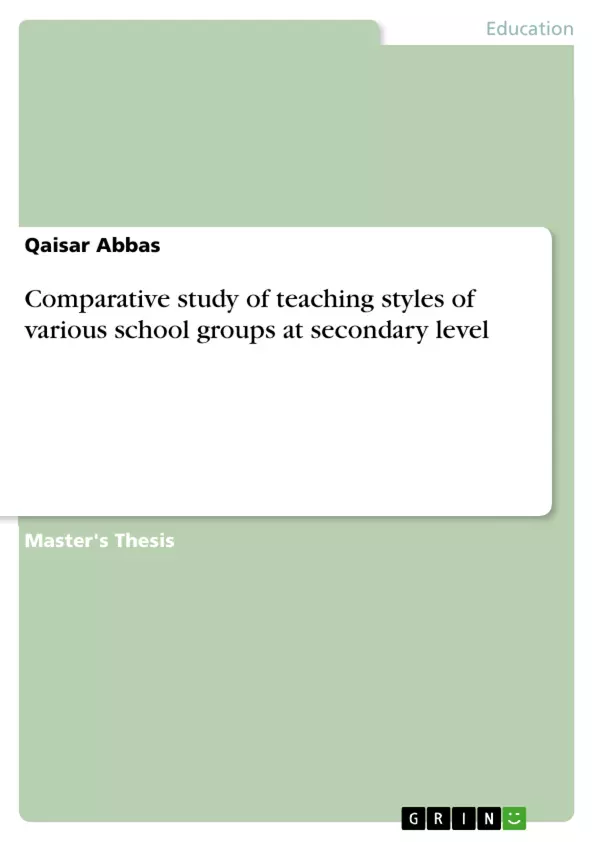Teaching style involves students in the learning process and supports them to improve critical thinking abilities. Customary teaching styles have progressed with the arrival of distinguished teaching, stimulating teachers to modify their teaching styles towards pupils’ learning requirements. The present study was intended to compare teaching styles of teachers working in secondary schools in district Chiniot of Punjab.
There were three objectives which were probed by the respondents to discover and compare teaching styles of teachers working in public and private secondary schools. The sample of 240 teachers from 24 public and private secondary schools was selected randomly from district Chiniot. A questionnaire developed and used by Grasha (1996) in many countries, was used as research instrument to collect data. The responses were analyzed through SPSS (V-20) to find out Mean, Standard Deviation, and Frequency Distributions for the description of data. Values of t-test were also applied to measure significant difference among various variables related to research questions.
It was concluded by analysis that there were five teaching styles found in public and private school categories. It was revealed that in public and private school categories there was no significant difference observed on expert, facilitator and delegator teaching styles. Only significant difference was found on formal authority and personal model teaching styles in favour of public school category.
Inhaltsverzeichnis (Table of Contents)
- CHAPTER 1
- INTRODUCTION
- 1.1 Statement of the Problem
- 1.2 Objectives of the Study
- 1.3 Research Questions
- 1.4 Significance of the Study
- 1.5 Delimitations of the Study
- CHAPTER 2
- LITERATURE REVIEW
- 2.1 What is Education?
- 2.2 Importance of Education
- 2.3 Types of Education
- 2.4 Pakistani Education System
- 2.5 Levels of Education
- 2.6 The Concept of Teaching
- 2.7 What is Teaching Method?
- 2.8 What is Teaching Approach?
- 2.9 What is Teaching Technique?
- 2.10 What is Teaching Strategy?
- 2.11 What is Teaching Style?
- 2.12 Assessment System in Pakistan
- 2.13 Understanding our Teaching Styles
- 2.14 The Role Teachers Play
- 2.15 Relevant Research Studies on Teaching Styles
- 2.16 Summary of Literature Review
- CHAPTER 3
- MATERIALS AND METHODS
- 3.1 Research Design
- 3.2 Research Questions
- 3.3 Population of the Study
- 3.4 Sample of the Study
- 3.5 Instrumentation
- 3.6 Administration of the Instrument
- 3.7 Scoring Procedures
- 3.7 Data Collection
- 3.8 Data analysis
- CHAPTER 4
- ANALYSIS OF THE DATA
- 4.1 Presentation and Data Analysis
- 4.2 Demographic Presentation of Teachers
- 4.3 Analysis of Quantitative Statements
- 4.4 Teaching Style-wise Analysis
- 4.5 Discussions
- CHAPTER 5
- SUMMARY, FINDINGS, CONCLUSION AND RECOMMENDATIONS
- 5.1 Summary of the Study
- 5.2 Findings of the Study
Zielsetzung und Themenschwerpunkte (Objectives and Key Themes)
This thesis aims to conduct a comparative study of teaching styles employed by various school groups at the secondary level in District Chiniot. The research analyzes different teaching styles and their effectiveness in diverse educational settings. The primary objective is to understand the relationship between teaching styles and student learning outcomes within the context of the Pakistani education system. Key themes explored in this study include:- Teaching Styles in Secondary Education
- Factors influencing teaching styles
- Impact of teaching styles on student learning
- Comparative analysis of teaching styles in different school settings
- Recommendations for improving teaching practices and student outcomes
Zusammenfassung der Kapitel (Chapter Summaries)
Chapter 1 introduces the research problem, outlines the study's objectives, research questions, significance, and delimitations. Chapter 2 provides a comprehensive review of relevant literature pertaining to education, teaching styles, and the Pakistani education system. It explores the importance of education, different types of education, and various levels within the Pakistani education system. The chapter further delves into the concepts of teaching methods, approaches, techniques, strategies, and styles, emphasizing the role of assessment in the Pakistani context. It also includes a review of existing research on teaching styles. Chapter 3 details the research methodology, including the research design, population, sample, instrumentation, data collection procedures, and data analysis techniques employed. Chapter 4 presents the analysis of collected data, focusing on demographic characteristics of teachers and the comparison of different teaching styles.Schlüsselwörter (Keywords)
This study centers on the exploration of teaching styles in secondary education within the context of the Pakistani education system. The key focus is on understanding the prevalence of different teaching styles in various school groups, their impact on student learning, and the factors influencing teachers' choice of teaching styles. The study utilizes a comparative approach, analyzing data from various schools in District Chiniot to identify patterns and differences in teaching practices. The research contributes to the broader discourse on effective teaching strategies, educational quality, and student outcomes in the Pakistani education landscape.- Quote paper
- Qaisar Abbas (Author), 2015, Comparative study of teaching styles of various school groups at secondary level, Munich, GRIN Verlag, https://www.grin.com/document/480113



